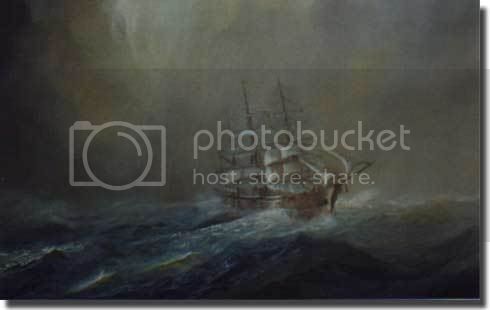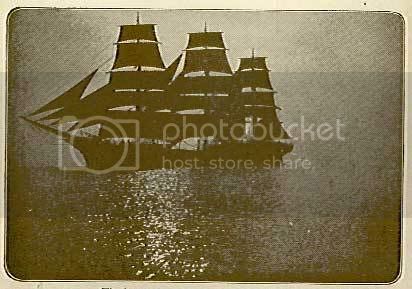SMS Seeadler

The above is a painting of the SMS Seeadler.
Built on the Clyde in 1888, Pass of Balmaha was owned by the River Plate Shipping Company of New York, and in June of 1915, fully loaded with cotton bound for Archangel, she was stopped by a British patrol north west of Cape Wrath. A boarding party was put on board, and she was ordered to proceed into a Scottish port so that she could be examined.

This a brooding/arty type picture of picture of the Pass of Balmaha
But before the Pass of Balmaha could reach port, a German Submarine U-36, commanded by Kapitanleutnant Graefe seized her, put a Midshipman in command and sent her off to Cuxhaven, with the British boarding party still in her hold. At this stage the ship was named Walter, and the decision was madeby the Germans to convert her into an Armed Raider.
Two 8.8 cm. guns were mounted and hidden behind hinged gunwhales, just aft and behind the forecastle, machine guns were also mounted on board.
The ship was known in Naval records as Seeadler or Sea Eagle, had a registered tonnage of 1,571, and fully loaded was 4,500 tons. She was 83 metres long with a 11.8 metre beam, and a draught of 5.5 metres, and under her diesel engine could make about 9 knots. Sails of course were her main means of propulsion.
Please be aware that at this time there were many sailing ships still plying the world's oceans, and the large four masted barques carrying wheat from Australia to Europe still operated until about 1939.
In seeking to disguise Seeadler as a similar Norwegian vessel Maleta and with typical German thoroughness prevailing, in von Luckner's cabin, pictures of both the King and Queen of Norway, plus King Edward V11 of England were all featured. Norwegian instruments such as a barometer and chronometer were also in evidence, and a number of his crew could speak Norwegian.
A number of unforseen delays took place, and when the German Maleta was ready for sea, her true sister had sailed from Denmark, and all this planning came to nought.
Another search of Lloyd's Register to come up with a suitable name brought to light, Carmoe, but no one seemed to know where she might be found, but at the last minute, a Norwegian newspaper revealed that the real vessel carrying that name had only recently been stopped and examined by British patrols. Once again the German plans were foiled.
There is some evidence to suggest that von Luckner named his ship Irma, after his fiancee, but the name Hero may have also been chosen. At any rate the idea was that it was a Norwegian ship with a load of timber bound for Melbourne, Australia.
SMS Seeadler carrying false papers and a deliberately damaged log book, silently slipped out of the river Weser on the 21st of December 1916, planning to skirt up the coast of Norway, to then sneak round the tip of Northern Scotland, and run free into the Atlantic.
The next instalment will be Part One of the Voyage of the SMS Seeadler
Regards
Sean













